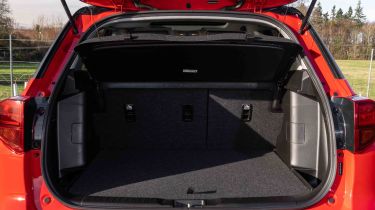Suzuki Vitara - Practicality, comfort and boot space
The Suzuki Vitara is practical enough, although there are more versatile small SUVs around

|
Dimensions | |
|
Length |
4,175mm |
|
Width |
1,775mm |
|
Height |
1,610mm |
|
Number of seats |
5 |
|
Boot space |
362 litres (1.4 Boosterjet), 298 litres (1.5 Hybrid) |
As an all-seasons car, the four-wheel-drive version of the Vitara is a practical choice – it might not climb a mountain or cross a river like the Land Rover Defender, or even the old Vitara, but it’s perfectly capable of crossing a muddy field or finding traction on icy roads where two-wheel-drive cars would scrabble for grip.
The front-driven versions are less versatile, but as with other crossover models you get a commanding, SUV-style view of the road ahead, and for many drivers, the greater fuel efficiency the 2WD system offers will outweigh the frequency that four-wheel drive will be needed.
Unlike previous Vitara generations, there’s no three-door version, so all models are equally practical. It’s easy for drivers to get comfortable, thanks to the wide range of seat and steering wheel adjustments. The reasonably thin roof pillars and large door mirrors help with visibility, but if you need extra help, then the mid-range SZ-T adds a reversing camera, and the top-of-the-range SZ5 comes with front and rear parking sensors.
The front doors have large storage bins, although the glove box is a bit on the small side.
Size
Because it’s 125mm shorter overall (with a 100mm shorter wheelbase) than the Suzuki S-Cross, the Suzuki Vitara doesn’t have the same amount of interior space, but it's still a spacious family car.
Used - available now

2016 Suzuki
Vitara
65,790 milesManualPetrol1.6L
Cash £8,400
2020 Suzuki
Vitara
65,989 milesManualPetrol1.4L
Cash £13,300
2019 Suzuki
Vitara
13,856 milesAutomaticPetrol1.4L
Cash £15,187
2020 Suzuki
Vitara
44,287 milesManualPetrol1.4L
Cash £10,500At 4,175mm long, 1,775mm wide and 1,610mm tall, the Vitara is slightly bigger than the Nissan Juke (4,135mm x 1,765mm x 1,565mm) in all directions.
Leg room, head room & passenger space
The high-sided design means there’s lots of rear headroom. Legroom is generous enough for all but the tallest adults.
If you want to emphasise the feeling of space, you can opt for a panoramic roof with a large 560mm opening, although on our test car, it suffered an irritating rattle (early test cars sometimes have this issue). The sunroof impacts headroom in the rear seats – not an issue if you mainly carry children, but six-footers will find it a problem.
As with most small SUVs, two ISOFIX child seat mounting points are provided on the rear seats' outer positions.
Boot
A boot capacity of just 362 litres (increasing to 645 litres with the rear seats folded) is fairly small for a car of this size. The 1.5 Hybrid has an even smaller boot of 289 litres due to the hybrid system taking up space, making it more capacious than a supermini. Many rivals, such as the SEAT Arona, Renault Captur, and Peugeot 2008, are all capable of hauling more luggage.
At least it’s a well-thought-out shape, though – square, with a wide opening and a moveable boot floor to bring the loading area level with the boot lip. It also provides an area to store items out of sight.
Towing
The Suzuki Vitara has a modest 1,200kg maximum braked trailer towing capacity compared to some small SUVs. Dedicated caravan types must go for the four-wheel drive ‘4Motion’ Volkswagen T-Roc, which can tow up to 1,700kg in both 2.0-litre petrol and diesel forms.








